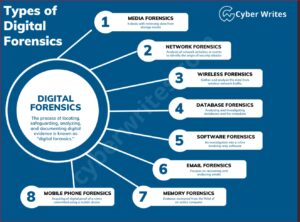
What Is Digital Forensics?
Digital forensics focuses on locating, preserving, analyzing, and presenting evidence stored in digital form. From computers and smartphones to drones and shipborne equipment, almost any device can yield crucial evidence.
There are many uses for digital forensics research, but the most typical is to prove or disprove a theory in court, whether for a criminal or civil case.
A computer, mobile phone, server, or network are some examples of growing number of digital media devices. The most effective methods and equipment are given to the forensic team to handle challenging digital-related cases.
The investigative process typically involves:
- At the crime scene- Seizure of devices (Phones, computers, smartwatches, etc.)
- At the police lab- Imaging and acquisition of data
- In-depth analysis
- Documentation and reporting
Digital forensics is not only critical in criminal trials but also in corporate incident response, where breaches or fraud require immediate evidence collection.
Historical Milestones in Digital Forensics
- 1978 – Florida Computer Act marks the start of legal recognition of computer crimes.
- 1984 – FBI launches the Computer Analysis and Response Team (CART).
- 1998 – UK’s ACPO issues the first Good Practice Guide for Digital Evidence.
Today, many of these early principles are upheld as global standards in courts of law.
Challenges Facing Digital Forensics Investigators
Investigators face growing challenges:
- Cloud computing complicates evidence collection.
- Criminals hide data using covert channels.
- Criminals don’t always take their trackable devices with them when committing crimes.
- Conflicting timestamps create difficulties in timeline analysis.
- Jurisdictions differ in how they handle digital evidence.
As one analyst noted, “The volume of digital evidence is exploding—yet its fragility makes it more challenging to preserve than physical evidence.”
The Future of Crime Solving
With tools like FTK Imager, Xplico, Paladin, and ProDiscover Forensic, agencies can capture and analyze massive data sets quickly. Digital forensics and behavioral science will continue to evolve side by side, strengthening criminal investigations and ensuring that justice is both swift and accurate.


